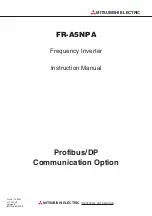
Goodrive3000 series medium voltage VFD
Moudbus protocol
-192-
8 Moudbus protocol
8.1 Overview
This chapter describes the communication of the VFD.
The VFD provides RS485 communication interfaces and adopts the master-slave communication based on the
international standard MODBUS communication protocol. You can implement centralized control (setting commands for
controlling the VFD, modifying the running frequency and related function code parameters, and monitoring the working
state and fault information of the VFD) through PC/PLC, upper control computer, or other devices to meet specific
application requirements.
8.2 MODBUS protocol instruction
MODBUS is a software protocol, a common language used in electronic controllers. By using this protocol, a controller
can communicate with other devices through transmission lines. It is a general industrial standard. With this standard,
control devices produced by different manufacturers can be connected to form an industrial network and be monitored in a
centralized way.
The Modbus protocol provides two transmission modes, namely American Standard Code for Information Interchange
(ASCII) and remote terminal units (RTU). On one Modbus network, all the device transmission modes, baud rates, data
bits, check bits, end bits, and other basic parameters must be set consistently.
A Modbus network is a control network with one master and multiple slaves, that is, on one Modbus network, there is only
one device serving as the master, and other devices are the slaves. The master can communicate with any single slave or
with all slaves. For the single-visiting command, the slave must send back a response message; for the broadcasting
message from the master, the slave does not need to send back a response message.
8.3 Application of Modbus
The VFD uses Modbus RTU mode and communicates through RS485 interfaces.
8.3.1 RS485
RS485 interfaces work in half-duplex mode and transmit data signals in the differential transmission way, which is also
referred to as balanced transmission. The two-wire RS485 interface uses a twisted pair, in which one wire is defined as A
(+), and the other B (-). Generally, if the positive electrical level between the transmission drives A and B ranges from +2V
to +6V, the logic is "1"; and if it ranges from -2V to -6V, the logic is "0".
On the VFD terminal block, the 485+ terminal corresponds to A, and 485- corresponds to B.
The communication baud rate (P14.01) indicates the number of bits sent in a second, and the unit is bit/s (bps). A higher
baud rate indicates faster transmission and poorer anti-interference capability. When a twisted pair of 0.56mm (24 AWG)
is used, the maximum transmission distance varies according to the baud rate, as described in the following table.
Baud rate
Max. transmission
distance
Baud rate
Max. transmission distance
2400BPS
1800m
9600BPS
800m
4800BPS
1200m
19200BPS
600m
In long-distance RS485 communication, it is recommended that you use shielded cables, and use the shielding layer as
the ground wire.
When there are fewer devices and the transmission distance is short, the whole network works well without terminal load
resistors. The performance, however, degrades as the distance increases. Therefore, it is recommended that you use a
120 Ω terminal resistor when the transmission distance is long.
8.3.1.1 Application to one VFD
Figure 8-1 is MODBUS wiring diagram for the network with one VFD and PC. Generally, PCs do not provide RS485
















































